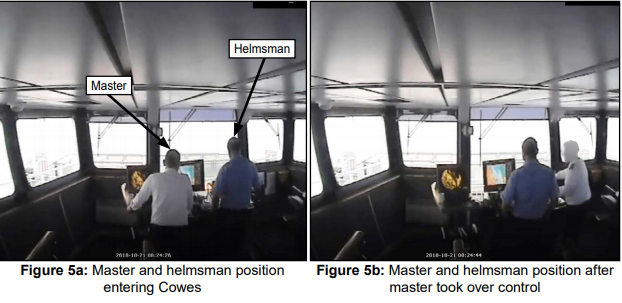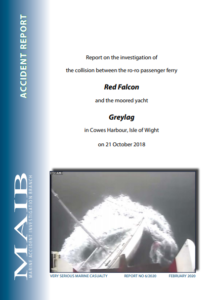The UK MAIB launched a new investigation report concerning a collision between the ro-ro passenger ferry Red Falcon and the moored yacht Greylag which was sunk on its mooring as a result.
The Incident
On Sunday, October 21, 2018, the ro-ro passenger ferry Red Falcon had entered the Cowes Harbour having a reduced visibility due to fog and the helmsman experienced difficulty steering due to the lack of visual references and his lack of practice steering by digital compass alone into Cowes Harbour.
In light of the helmsman’s difficulty, the master took control and operated the steering and propulsion himself.
Critically, the role of keeping an oversight of operations was then lost
… the report comments.
The reduced visibility impacted the master who relied solely upon his instrumentation. However, his lack of practice using instruments, but most importantly to manoeuvre the vessel, led to in over-correction of steering, which led to the vessel swinging to port out of the channel, ultimately turning through 220º.
The ro-ro then collided with the moored yacht which sank.
It is reported that the collision occurred because the master lost his orientation in the fog and sailed the vessel towards the wrong direction.
He became disorientated because he was sufering from cognitive overload due to high stress, lack of visibility, bridge equipment ergonomics, and the breakdown of support from the bridge team.
Following, the master’s actions and the lack of communication also affected the bridge team who became disengaged, leading to an absence of any challenge to the master’s decisions.

Conclusions
- The collision and grounding occurred because the master became disorientated in the fog and inadvertently drove the ferry in the wrong direction.
- The helmsman was inexperienced at steering the vessel into Cowes Harbour and was insufficiently practiced at steering by digital compass alone.
- The inherent limited directional stability of Red Falcon’s hull form, coupled with tidal stream effects, master’s frequent course orders, and the lack of visual references, led to the helmsman struggling to maintain the ship’s heading.
- When the master took over operating the controls, the oversight of operations was lost, the members of the bridge team started to act in isolation and did not adequately support the master
- The ergonomic layout of the navigation equipment did not support single person operation of the ship’s controls from the side of the console
- With no visual references the master experienced significant difficulty in controlling Red Falcon and was fortunate not to hit the marina wall, yachts or navigation marks in the vicinity
- The master fixated on the ECS and VSP controls due to high task load and levels of stress. This compounded by the lack of visibility and the breakdown of bridge team support resulted in him becoming disorientated
- The electronic chart system relied on a manual switch to provide heading information, which was not operated by the master as he rushed between the Cowes and Southampton ends
- The master became focused on the ECS and used the information displayed to drive his decision-making. The erroneous heading information being displayed supported the master’s belief that he was driving Red Falcon back into the channel
- The actions of the master and the lack of communications of his intent, resulted in the bridge team becoming disengaged, and not supporting the master adequately.
- A rapid deterioration in visibility in the harbour after a ferry had entered the channel was unusual, but not unforeseeable. Emergency training for such a scenario would have helped ensure that all members of the bridge team were familiar with and practiced in their respective roles, and able to react quickly when the need arose.
The C/O became confused, mentally rejected the picture displayed by the radar and believed the ECS display instead. In the circumstances, he did not have sufficient time to re-evaluate the ferry’s position, and, therefore, did not challenge the master’s actions.
- The roles of individual bridge team members were not sufficiently detailed within the company’s reduced visibility procedures.
- Cowes Yacht Haven did not have a comprehensive suite of risk assessments that included the hazard of collision between commercial vessels and raft of yachts on its outer pontoons.
Actions Taken
#1 Red Funnel
- Undertaken its own internal investigation and has shared its report fndings with Cowes Harbour Commission.
- Implemented a new navigation procedure, which includes assessment of helmsman competence, regular frequent practice steering through Cowes Harbour and regular practice at steering by compass alone.
- Amended its blind pilotage routine to include rotation of ratings’ duties and more accurate detailed recording of drill composition within its training management system.
- Reviewed the content of its bridge resource management training programme, increased its length to 2 days, included emergency scenarios and has involved deck ofcers, engineers and ratings.
- Commenced regular navigation assessments of vessel operations, which includes the implementation of resource management techniques. In addition, several shore management team members have undertaken navigation assessment training.
- Included ratings and engineers in company crew resource management training.
- Joined an industry crew resource management group at the United Kingdom Chamber of Shipping for the purpose of developing and implementing best practice.
- Amended the company ship-handling training for C/Os, to include aspects of anticipated vessel operations and the practicing of emergency scenarios.
- Adjusted the positioning of the radar units on all ‘Raptor’ class vessels so that they are more visible to the person conning the vessel from the side of the forward and aft maneuvering consoles.
- Installed voice recording capability to the wheelhouse of all ‘Raptor’ class vessels.
#2 Cowes Harbour Commission
- Undertaken its own investigation and shared its report fndings with Red Funnel.
- Issued a temporary General Direction to mariners for movements in periods of restricted visibility.
- Reviewed its risk assessments and produced a new assessment for ‘Red Funnel raptors being set out of the fairway in restricted visibility due to a potentially strong cross current in the Inner fairway’.
- Reviewed its safety management plan and its emergency response plan for adequacy.
- Reviewed its aids to navigation, including buoyage, tidal stream indicators and visibility monitors.
- Included local marina operators in its safety committee & forum.
To explore more on UK MAIB’s investigation report click herebelow

































































